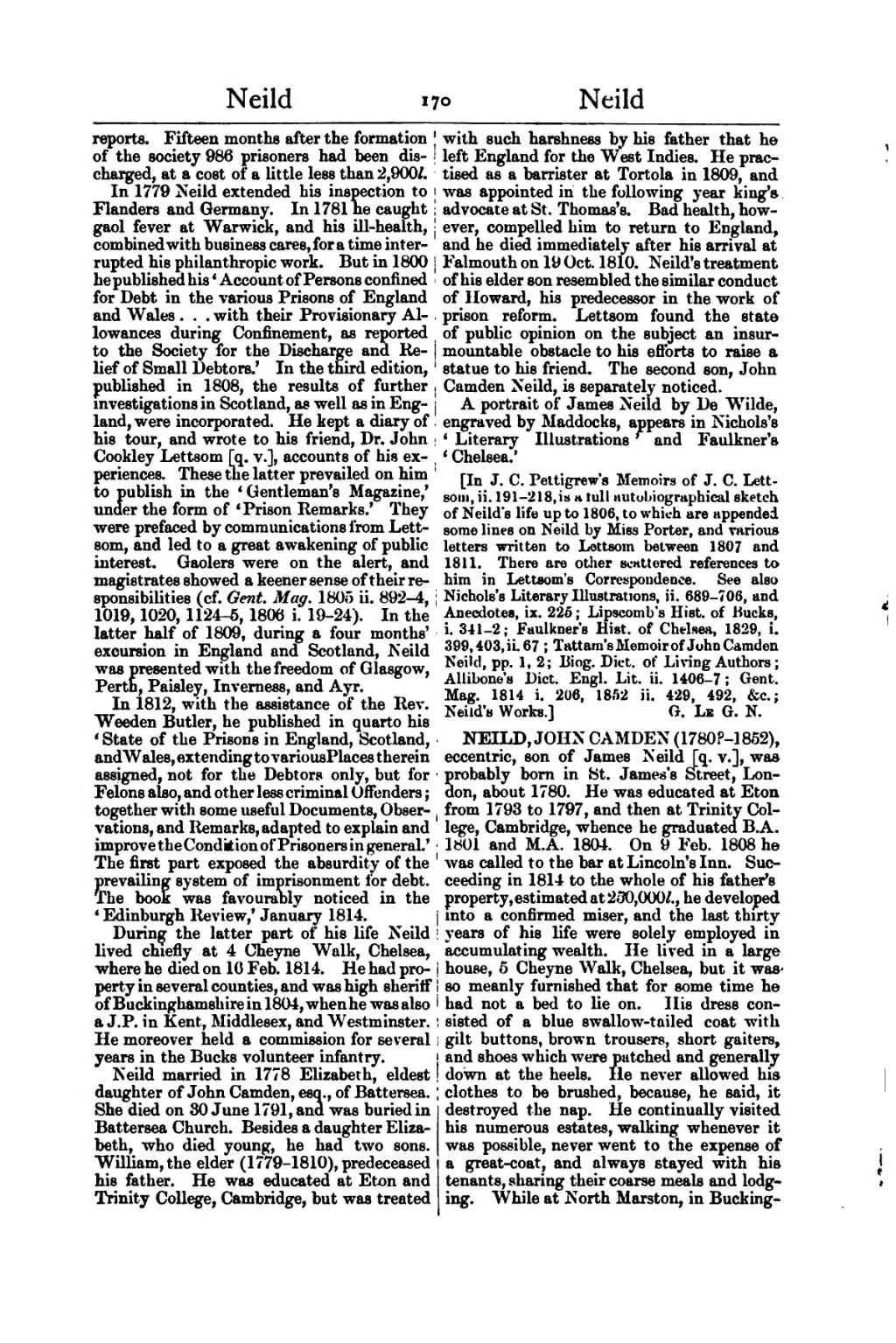reports. Fifteen months after the formation of the society 986 prisoners had been discharged, at a cost of a little less than 2,900l.
In 1779 Neild extended his inspection to Flanders and Germany. In 1781 he caught gaol fever at Warwick, and his ill-health, combined with business cares, for a time interrupted his philanthropic work. But in 1800 he published his ‘Account of Persons confined for Debt in the various Prisons of England and Wales … with their Provisionary Allowances during Confinement, as reported to the Society for the Discharge and Relief of Small Debtors.’ In the third edition, published in 1808, the results of further investigations in Scotland, as well as in England, were incorporated. He kept a diary of his tour, and wrote to his friend, Dr. John Cookley Lettsom [q. v.], accounts of his experiences. These the latter prevailed on him to publish in the ‘Gentleman's Magazine,’ under the form of ‘Prison Remarks.’ They were prefaced by communications from Lettsom, and led to a great awakening of public interest. Gaolers were on the alert, and magistrates showed a keener sense of their responsibilities (cf. Gent. Mag. 1805 ii. 892–4, 1019, 1020, 1124–5, 1806 i. 19–24). In the latter half of 1809, during a four months' excursion in England and Scotland, Neild was presented with the freedom of Glasgow, Perth, Paisley, Inverness, and Ayr.
In 1812, with the assistance of the Rev. Weeden Butler, he published in quarto his ‘State of the Prisons in England, Scotland, and Wales, extending to various Places therein assigned, not for the Debtors only, but for Felons also, and other less criminal Offenders; together with some useful Documents, Observations, and Remarks, adapted to explain and improve the Condition of Prisoners in general.’ The first part exposed the absurdity of the prevailing system of imprisonment for debt. The book was favourably noticed in the ‘Edinburgh Review,’ January 1814.
During the latter part of his life Neild lived chiefly at 4 Cheyne Walk, Chelsea, where he died on 16 Feb. 1814. He had property in several counties, and was high sheriff of Buckinghamshire in 1804, when he was also a J.P. in Kent, Middlesex, and Westminster. He moreover held a commission for several years in the Bucks volunteer infantry.
Neild married in 1778 Elizabeth, eldest daughter of John Camden, esq., of Battersea. She died on 30 June 1791, and was buried in Battersea Church. Besides a daughter Elizabeth, who died young, he had two sons. William, the elder (1779–1810), predeceased his father. He was educated at Eton and Trinity College, Cambridge, but was treated with such harshness by his father that he left England for the West Indies. He practised as a barrister at Tortola in 1809, and was appointed in the following year king's advocate at St. Thomas's. Bad health, however, compelled him to return to England, and he died immediately after his arrival at Falmouth on 19 Oct. 1810. Neild's treatment of his elder son resembled the similar conduct of Howard, his predecessor in the work of prison reform. Lettsom found the state of public opinion on the subject an insurmountable obstacle to his efforts to raise a statue to his friend. The second son, John Camden Neild, is separately noticed.
A portrait of James Neild by De Wilde, engraved by Maddocks, appears in Nichols's ‘Literary Illustrations’ and Faulkner's ‘Chelsea.’
[In J. C. Pettigrew's Memoirs of J. C. Lettsom, ii. 191–218, is a full autobiographical sketch of Neild's life up to 1806, to which are appended some lines on Neild by Miss Porter, and various letters written to Lettsom between 1807 and 1811. There are other scattered references to him in Lettsom's Correspondence. See also Nichols's Literary Illustrations, ii. 689–706, and Anecdotes, ix. 225; Lipscomb's Hist. of Bucks, i. 341–2; Faulkner's Hist. of Chelsea, 1829, i. 399, 403, ii. 67; Tattam's Memoir of John Camden Neild, pp. 1, 2; Biog. Dict. of Living Authors; Allibone's Dict. Engl. Lit. ii. 1406–7; Gent. Mag. 1814 i. 206, 1852 ii. 429, 492, &c.; Neild's Works.]
NEILD, JOHN CAMDEN (1780?–1852), eccentric, son of James Neild [q. v.], was probably born in St. James's Street, London, about 1780. He was educated at Eton from 1793 to 1797, and then at Trinity College, Cambridge, whence he graduated B.A. 1801 and M.A. 1804. On 9 Feb. 1808 he was called to the bar at Lincoln's Inn. Succeeding in 1814 to the whole of his father's property, estimated at 250,000l., he developed into a confirmed miser, and the last thirty years of his life were solely employed in accumulating wealth. He lived in a large house, 5 Cheyne Walk, Chelsea, but it was so meanly furnished that for some time he had not a bed to lie on. His dress consisted of a blue swallow-tailed coat with gilt buttons, brown trousers, short gaiters, and shoes which were patched and generally down at the heels. He never allowed his clothes to be brushed, because, he said, it destroyed the nap. He continually visited his numerous estates, walking whenever it was possible, never went to the expense of a great-coat, and always stayed with his tenants, sharing their coarse meals and lodging. While at North Marston, in Bucking-
